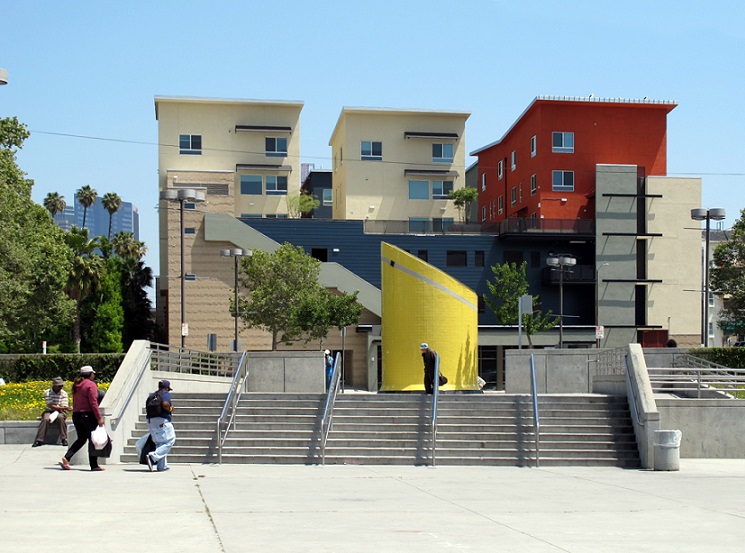
IN THIS ISSUE:
Green Infrastructure Aims to Reshape Philadelphia
Grantee Spotlight: Planning for Livable Military Communities
Connecting Affordable Housing and Public Transportation in Los Angeles
Energy-Efficiency Program Targets Affordable Housing Preservation
Connecting Affordable Housing and Public Transportation in Los Angeles

Residents of the 90 affordable units in MacArthur Park Apartments Phase A have easy access to the adjacent Westlake/MacArthur Park Metro station. Image courtesy of Cheryl H. Tamura
In June 2012, the city of Los Angeles celebrated the opening of the MacArthur Park Apartments Phase A, which features 90 affordable apartments located adjacent to the Los Angeles Metropolitan Transit Authority’s (Metro’s) Westlake/MacArthur Park station. By offering residents affordable housing and an alternative to private automobiles, this transit-oriented development provides financial sustainability for its residents as well as environmental sustainability for the region. The project, which was financed through a public-private collaboration, is the first part of a two-phase affordable housing development in Los Angeles’ historic Westlake/MacArthur Park neighborhood.
Accessible, Affordable, and Environmentally Sensitive Housing
Of MacArthur Park Apartments Phase A’s 90 units, 8 are affordable to households earning up to 20 percent of area median income (AMI), 11 are affordable to households earning up to 30 percent of AMI, 11 are affordable to households earning up to 35 percent of AMI, 15 are affordable to households earning up to 50 percent of AMI, and 44 are affordable to households earning up to 60 percent of AMI (one unit is reserved for the manager). All Phase A rental units have two or three bedrooms to cater to families. In addition to the residential units, Phase A features 15,000 square feet of retail space and a parking garage with 91 spaces for residents, 42 spaces for retail customers and staff, and 100 spaces for Metro commuters, as well as 24 bicycle parking spaces.
The developer, McCormack Baron Salazar, incorporated sustainable features in Phase A to lower utility costs and offer families a safe environment. The development features double-glazed windows, high-efficiency heating and cooling systems, and upgraded insulation. In addition, the development uses recycled materials, nontoxic paints and materials, and water-conserving plumbing fixtures.
Perhaps Phase A’s most sustainable feature is its location adjacent to Metro’s Westlake/MacArthur Park station, offering residents easy access to downtown Los Angeles and other area destinations. To encourage MacArthur Park residents to use public transit, each household is given a monthly Metro pass. According to Tony Salazar, president of West Coast operations at McCormack Baron Salazar, low-income households living in high-cost areas like Los Angeles often devote about 57 percent of their income to housing and transportation costs; providing these families with affordable housing and transit options reduces the percentage of income spent on housing and transportation and improves their finances.
In addition to reducing households’ combined housing and transportation costs, affordable, transit-oriented development contributes to environmental sustainability. Citing studies in Los Angeles and other California cities, the California Housing Partnership Corporation (CHPC) notes that people who moved to transit-oriented developments accounted for three fewer tons of carbon dioxide being released into the atmosphere each year, based on reduced vehicle miles traveled. CHPC further claims that the degree of environmental benefits should be even greater for low-income people living in transit-oriented developments, since they are more likely to use transit than higher income households.
Public and Private Financing
A variety of public and private sources contributed to the approximately $45 million development costs for Phase A, of which $37 million was used to cover the residential portion. Metro supported Phase A through its Joint Development program, which facilitates development on Metro-owned land at transit stations that will increase ridership and help communities reach their land use and economic development goals. According to Greg Angelo, director of real property management and development for the county transportation authority, Metro provided a $4 million loan to construct a parking garage.
Phase A also received a $1.4 million loan from the now-defunct Community Redevelopment Agency of the city of Los Angeles (CRA/LA), which had initiated the Westlake Recovery Redevelopment Project in 1999 to develop and rehabilitate housing in the Westlake/MacArthur Park community, among other goals. Other public sources of funding included the California Department of Housing and Community Development’s Transit Oriented Development Housing program, the county housing authority’s City of Industry program, and the city Housing Department’s affordable housing trust fund.
Equity from the New Markets Tax Credit program and 4 percent low-income housing tax credits purchased by Goldman Sachs also helped finance the development. Approximately $1.5 million from the American Recovery and Reinvestment Act’s Tax Credit Assistance program, disbursed by the California Tax Credit Allocation Committee, filled the gap created by a diminished market for low-income housing tax credits during the recession. Private funding consisted of conventional financing from Bank of America and a deferred developer fee.
Success and Planning for Next Steps
According to Salazar, demand for the units in Phase A was very high. The developer received 2,000 applications, from which 90 families were selected by lottery. All the apartments were leased within weeks of the end of construction in mid-May 2012.
Phase B will provide the Westlake/MacArthur Park community with an additional 82 affordable units, 17,000 square feet of retail space, and a bicycle parking facility above the Westlake/MacArthur Park station. To compensate for the lack of CRA/LA funds, McCormack Baron Salazar is pursuing 9 percent low-income housing tax credits. The developer expects that the tax credits will be allocated in June 2013 and that construction will begin in December 2013 and be completed by January 2015.
